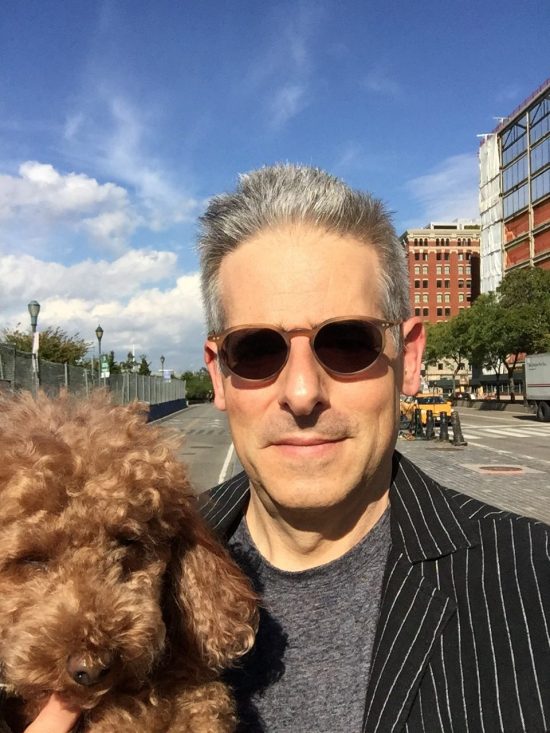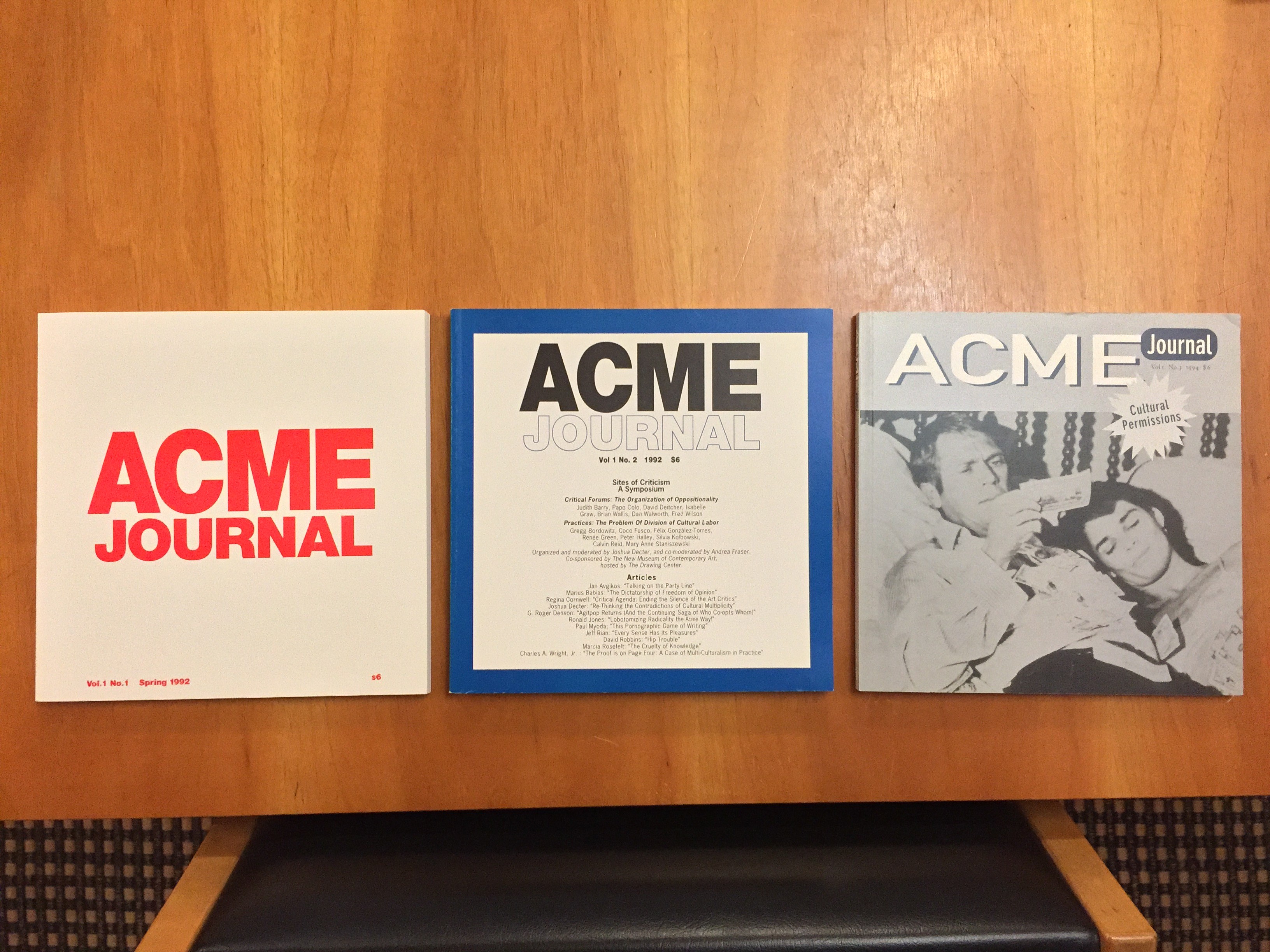Undaunted, however, in 1992, I launched Acme Journal, with the artist and writer John Miller. This journal was born from casual coffee meetings at Novocento cafe in SoHo with the late gallerist Colin de Land, who perceived our frustrations with art criticism and its publishing systems, and encouraged us to produce something new. Colin funded the first issue, but insisted that his role be kept anonymous, so that there would be no confusion that the journal was beholden to his gallery, American Fine Arts, which it certainly wasn’t. One of the central goals of Acme Journal was to challenge what we perceived as the restrictive norms of art criticism and arts writing at the time, and to offer a platform for critics, writers, artists, and curators that would encourage the kind of writing that could not be published elsewhere. At the same time, we were very aware that creating an ‘alternative’ art journal was itself a rather normative thing to do in the art world. In the editorial for the first issue of Acme Journal, published in the spring of 1992, Miller and I wrote:
“Our inaugural issue is inspired by contempt for what art criticism has become. At this juncture, the possibility of criticism may now lie in its parapraxes: the fissures, the inconsistencies, the ruptures, the self-indulgences, the whining and the complaining. Presenting a disunited front might be a virtue, since it unravels, among other things, the fiction of critical authority… thereby encouraging the frustration of its (normative) institutional tasks, functions, values, meanings and characteristics.”
Only three issues of Acme were produced. At the moment the journal became more successful in terms of readership and advertising, we made a very deliberate decision to end the publication. We considered this as an act of refusal, an acknowledgement that all alternative positions, any alterity, is a cultural, social and political construction that is easily recuperated as a new normal, so to speak. In a sense, we didn’t want the journal to become normalized. This was also perhaps a tacit admission that we were not able to rescue art criticism from itself. 🙂
Around this same time, I also began worrying that artists who claimed to be challenging institutional power might at the same time be seeking that institutional power, and I experienced a similar anxiety that art critics might be reproducing the power of things that they believed they were challenging. I became attracted to the notion that to have any ethics as a critic meant engaging in acts of self-criticality within the texture of the writing itself; and, to take responsibility for rhetorical claims made in art critical writing.
To recognize that making a rhetorical claim within the discursive space of art criticism (or any genre of criticism) is not in and of itself realpolitik; a translation would need to occur from the space of criticism into the realm of applied politics. And yet how would we be able to ascertain whether such a translation ever occurred?

Truth be told, these days, I refer to myself as a writer, curator and art historian (and occasionally as a theorist), but no longer include the category of art critic, because I think that the expression ‘art critic’ refers to people who are engaged professionally in the everyday business of producing art criticism, specifically art reviews. Some years ago, I decided to cease producing art reviews for the magazine-industrial-complex. Needless to say, critical thinking is what underpins all forms of critical writing, and at the same time, critical writing is a means of honing critical thinking. For me, critical thinking has always been more important than writing art criticism, per se, since art criticism is just one of a number of platforms, so to speak, through which to practice critical thinking. I’ve always endeavored to exercise critical thinking across multiple platforms, including curating, teaching, and yes, even occasionally on social media. I consider these platforms to be fluidly interrelated, in the sense that one can approach curating as an extension of critical thinking & critical writing, and vice-versa. I probably even use critical thinking in relation to breakfast, as ridiculous as this sounds. Critical thinking haunts my days and nights. 🙂
“Metacritical reflection can sometimes lead to annoying tautologies, or just overthinking the problems of criticism, for which there are no solutions anyway.”
In the preface to my 2014 book, Art is a Problem, I alluded to my anxieties about criticism:
“Critical writing may have the capacity to cut through the fog of art’s ambiguities and shed light on its contradictory place in the world, but such discourse can do nothing to vitiate these contradictions. To some, this is inspiring; for me, it is occasionally exasperating. Engaging in critical processes— i.e., questioning, pressuring, and troubling things as they appear to be— may temporarily reduce the psychic pain unleashed by the contradictions of art and its global systems, even though it is in no way ameliorative of these conditions. (For better results, take Ibuprofen.) One’s survival in this professional (para-professional) field, however, depends upon sublimating this state of affairs…. Another way to think about critical activity—whether it is expressed through writing, curatorial practice, journal editing, teaching, or organizing a symposium—is that by engaging in some form of it (as a negative dialectics, for instance), we are at the same time putting the best possible face on the reality that criticality (and criticism) is in the wilderness. In order to be critical, we must convince ourselves that our sovereignty as critical thinkers is meaningful and tangible, even while acknowledging that this very sovereignty is the result of precariously occupying a mental space that is at once inside and outside power. We find creative, even pleasurable, ways to maintain the self-delusion that our sovereignty as critical beings is beyond contradiction. It would be hypocrisy not to admit that my criticality is located both outside of and within these contradictions. If anything, this book reflects an ongoing struggle to reconcile the limits of criticality (and criticism) with a continuing desire to imagine that the questioning of things might have some relevance beyond a relatively closed discursive space or community (that is itself constituted both inside and outside power).”
Each time one writes art criticism, one is not only writing about art, but also writing about art criticism. In the sense that every act of critical writing about visual art – or, for that matter, critical writing on film, music, architecture, literature and other forms of cultural expression – is at the same time, intrinsically, an act of writing on criticism. And writing that reflects critically on itself is a kind of metawriting, even as we understand that writers are always reflecting upon writing as they write (and editing writing as they write the writing). Asking an art critic to reflect on art criticism is what I would characterize as a request to engage in a form of metacriticism, or perhaps, a form of critical theory. And I wonder about the value of meta-art criticism for the sake of meta-art criticism. If art criticism is reduced to being merely an act of naval-gazing, then it becomes a kind of homeless art criticism: art criticism wandering around, in search of its objects (and subjects). Metacritical reflection can sometimes lead to annoying tautologies, or just overthinking the problems of criticism, for which there are no solutions anyway. Of course, art criticism has been announcing for decades that it is in a state of crisis, and by doing so, it may be reproducing a crisis for art criticism— which ironically helps to draw attention to art criticism.
“But whereas everyone wants to curate everything, because curating is alluring, fun, cool sexy, and value-adding, the same cannot really be said of criticism.”
The underlying crisis of art criticism may always have been a sense of anxiety regarding the fading power of art critics as arbiters and gatekeepers of taste, value, and merit. For the most part, due to the economic and financial acceleration of the art markets, much of the former power (and this power was always a bit overstated) of art critics to influence art histories, art markets, and art as an instrument of financial speculation has increasingly migrated over to gallerists, auction houses, collectors & patrons, curators, and institutions. Is there any art critic who can be a kingmaker or queenmaker of artists, so to speak? Even if there are such powerful critics these days, the real issue is that art criticism cannot be allowed to interfere too adversely with the art markets; there’s just too much invested in art, and too much at stake for the art economies, for art critics to be allowed to do much more than shout from the sidelines, engage in hagiography, social scene gossiping, or cheerleading. This is logical, in a sense, because magazines cannot afford to alienate too many of their advertisers, or their economic model would collapse. And so, critics and criticism are tolerated, instrumentalized, and marginalized. I think our overeducated but underpaid art critics deserve better, alas. And there are some brilliant art critics, multiplying forms of art criticism, and various platforms for art criticism. I think part of the problem may be that art critics are not always intellectually honest: they occasionally reproduce the sorts of ethical conflicts that they claim to condemn. For example, when I noticed the same art critic writing sanctimoniously about the horrible impacts of gentrification on artists in New York City, then subsequently write in another publication about the wonders of new art zones in Mexico City (without mentioning the intense urban redevelopment and gentrification involved in those art zones), this makes me uneasy. Likewise, when a critic publicly and piously laments the inequities of the gallery system, but also attends VIP art gallery dinners, such inconsistency is demoralizing and saddening, particularly if critics won’t publicly acknowledge these contradictions. And while none of us can really stand outside of these broader structural contradictions, we should at least make an effort to not reproduce these contradictions; or at the very least, not pretend that these contradictions don’t exist.
Let’s not forget that social media is in the process of disrupting – or scrambling – some normative hierarchies of taste, value and merit, and this is having an impact on the traditional roles of the art critic, as well as the curator. Anyone with a Twitter, Facebook or Instagram account can be judge, jury and executioner of anything, which is a challenge to professional experts who consider themselves to the only people who are authorized to pass judgement. The barbarians are not only at the gate, but have climbed over it, and may want to trample the traditional gatekeepers of art and culture- perhaps as a populist attack on ‘elitism.’ The irony of populist attacks on elitism is that those engaged in these attacks probably have ulterior motives: they want to displace the traditional gatekeepers in order to place themselves in the position of the new gatekeepers, by substituting their non-expertise for expertise as a form of alt-expertise: in other words, to become the anti-elite elites, paradoxically. Social media is full of people who aren’t professional art critics engaging in amateur art criticism (or, art opinionating), just as social media is full of people who aren’t professional curators engaging in some kind of curating. But whereas everyone wants to curate everything, because curating is alluring, fun, cool sexy, and value-adding, the same cannot really be said of criticism. People tend to see criticism as aligned with the culture of snarking and trolling. And that’s a big turnoff for people, understandably. I think the truth is that most people don’t really like critics and criticism. I can’t really blame them. Critics can be annoying bastards, even if they might be necessary bastards. Truth be told, and I’m being a bit tongue-in-cheek here, artists generally only like critics when they say something nice about their work; likewise, curators tend to only like critics when they say something nice about their shows. And, needless to say, critics don’t take criticism well. 🙂
“Perhaps it would be better for art criticism to arrive before some art, so as to prevent certain art from happening in the first place, which would help both the artist, and the potential art audiences.”
So why did I stop doing art criticism on a regular basis? Well, I finally came to the realization, or an epiphany, after 30 years of writing criticism, that criticism always arrives too late. What do I mean by this? That art criticism arrives at the scene of art after the art has already happened, too late to stop the art from happening. Like the police arriving at the scene of a crime that has already happened. There is a sense of helplessness. Ideally, the police should arrive before the crime, to prevent the crime from taking place, which would help both the potential criminal and the potential victims of the crime. Now just replace police with art critic, and we can say that perhaps it would be better for art criticism to arrive before some art, so as to prevent certain art from happening in the first place, which would help both the artist, and the potential art audiences. I’m not necessarily endorsing an art critical version of Philip K. Dick’s notion of “precrime” (subsequently featured in the dystopic science fiction film, Minority Report), yet I increasingly feel that the project of art criticism is hamstrung by its temporal relation to the event of art. It always arrives too late. And so, we are faced with art criticism’s ontological dilemma (well, really, any genre of criticism): the event of art criticism is always antecedent to the event of art. But what if this temporal order were reversed, and the event of art criticism preceded the event of art? Now, realistically speaking, there is a significant historical body of art criticism that has accumulated over many years, and so art criticism is also before art. However, I’m alluding to the normative sequence of events wherein the act of art criticism responds to the event of art: an exhibition opens, the art critic visits the show, offers an interpretation, and renders a judgement. There is something about this logic, this way of being in the world, that I no longer found to be intellectually stimulating, so I opted out of it.
Maybe this is the crisis of art criticism for me: that it always arrives too late. Anyway, these days, with liberal democracy under threat by the forces of illiberalism, most people don’t wake up panicked in the middle of the night and scream out: ‘Help, art criticism is in crisis!’ Why would they? I certainly don’t. There are much bigger crises that we must contend with. Perhaps the deeper crisis for art criticism is that it is always arriving too late for its own crisis! 🙂

Copyright 2018 Joshua Decter.
Joshua Decter is a New York-based writer, curator, art historian and theorist.
Decter’s 2013 book, Art Is a Problem: Selected Criticism, Essays, Interviews and Curatorial Projects (1986-2012), published by JRP|Ringier, examines contemporary art in relation to its various ideological, public, discursive, and social contexts, and comprises seven chapters: Institutional Critique® and its Discontents; Aporia (art as politics, the politics of art); Everything is Social; Convoluted Cities; The (Un)De-definition of Art; What do we want from exhibitions?; On the Curatorial Road. Decter is co-author of the 2014 book, Exhibition as Social Intervention: ‘Culture in Action’ 1993, published by Afterall Books. His essay, ‘Art and the Cultural Contradictions of Urban Regeneration, Social Justice and Sustainability: Transforma Projects and Prospect.1 in Post-Katrina New Orleans,’ is included in the 2016 book, Public Servants: Art and the Crisis of the Common Good, published by the MIT Press/New Museum. Decter has contributed to Artforum, Afterall, Art Review, Mousse, Texte zur Kunst and other periodicals, and has authored numerous catalogue essays for museums and other art organizations. Decter has organized exhibitions at PS1, The Center for Curatorial Studies at Bard College, Apex Art, the Museum of Contemporary Art in Chicago, the Kunsthalle Vienna, and the Santa Monica Museum of Art. His exhibitions have been reviewed in The New York Times, Artforum, The Village Voice, Art Monthly, The Los Angeles Times, Art News, Der Standard, Le Monde, and elsewhere. He has taught at the University of Applied Arts Vienna, The School of Visual Arts, Cooper Union, the Center for Curatorial Studies at Bard College, School of the Art Institute of Chicago, New York University, UCLA, Art Center College of Design in Pasadena, and Bennington College. From 2007 to 2011, as Director of the Master of Public Art Studies Program at USC, Decter founded the M.A. Art and Curatorial Practices in the Public Sphere program. He is currently on the faculty of the School of Visual Art’s MA Curatorial Practice program in New York. Decter has organized and participated in numerous international symposia over the past 30 years.


